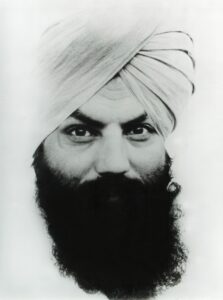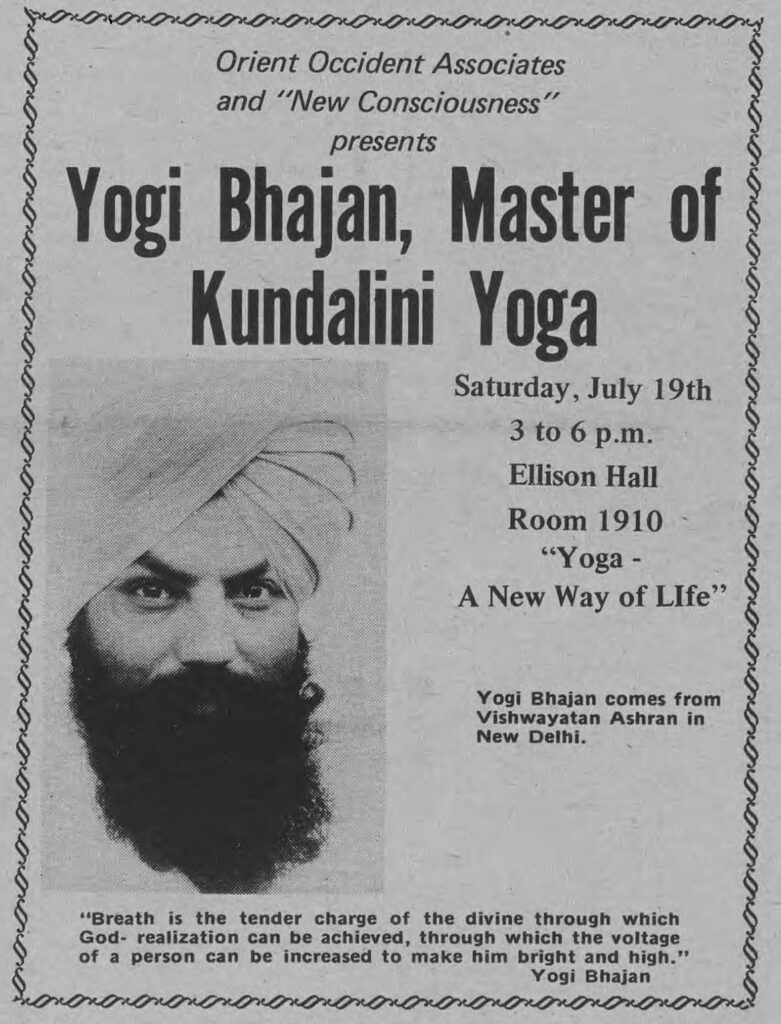When Misseeing Is Believing: The Self-Reflected Image and Kundalini Yoga
Unusual experiences during meditation may help to explain why some people stay in abusive religious communities

(White Tantric Yoga. Image source: studentsofyogibhajan)
Between 1963 and 1965, two psychiatrists, Luis Schwartz and Stanton Fjeld, conducted an experiment on sixty-four people in Saint Louis, Missouri. One by one, Schwartz and Fjeld took them to a dark room lit by only a single, small lightbulb and had them stare at their reflection in a four-inch square mirror placed two feet in front of them for thirty minutes. As a tape recorder rolled, each participant reported on their experiences out loud to the psychiatrists.
A large number of the participants saw their reflections distort, disappear, move, or change color. An even higher percentage had intense emotional reactions, including fear, sadness, and aggression. Some felt these emotions within themselves or saw them happening in their reflection. Others had physical reactions and wept or shook. One person even vomited. About three-quarters of the subjects saw or felt a connection to “significant persons or important events in their lives” like a deceased relative or former lover.
The pair of researchers published their findings a few years later in an article titled “Illusions Induced by the Self-Reflected Image.” They were at a loss to explain why these things happened, but they were clear about the intensity of the effects. Staring at oneself in a dimly lit mirror for an extended period of time was comparable to taking hallucinogenic drugs.
Schwartz and Fjeld were neither the first nor the last scientists to research the distortions that occur when people stare for an extended time at themselves in a mirror, into the eyes of another, or at the portrait of someone else. For nearly a century these phenomena have been studied by scientists in Italy, Brazil, Peru, Britain, the United States, and elsewhere.

(Postcard depicting the folk practice of a woman gazing into a dimly-lit mirror on Halloween night to see her future husband. Circa 1900, collection of the author.)
People have also had profound religious experiences arise from staring at someone’s face and seeing it distort. Dick Anthony, a forensic psychologist who was prominent in debates over brainwashing in the 1980s, gazed at a photograph of the guru Meher Baba in 1967 while he was staying in a cabin as a graduate student. The image wavered and dissolved. Anthony then felt the “striking presence” of Meher Baba in the cabin with him and became a devotee. Years earlier in Harlem, a member of the Ethiopian Hebrew Commandment Keepers named Brother William testified to the congregation after Friday evening services that he saw their leader, Rabbi Wentworth Arthur Matthew, “disappear with my own eyes.”
I had heard numerous stories like this within a group I have been researching and writing about for the last decade, the Healthy, Happy, Holy Organization, or 3HO, founded by the late Yogi Bhajan (1929-2004). When members of 3HO gazed into Yogi Bhajan’s photograph, a meditation they called “Tratakam,” they heard him speak or saw his face change expression. When they did “White Tantric Yoga,” a series of meditative exercises in pairs while staring into each other’s eyes, they saw their partner’s face change into another person or an animal.
These accounts were intriguing, and they motivated me to delve into the scientific research on face-gazing and to conduct a survey among members of 3HO. In time, I began to appreciate that these experiences were more than strange anecdotes, but were a powerful factor in the turbulent history of the organization. For many, they were a reason to remain in an abusive religious group long after it would seem sensible to stay.
The Weaver of Energy and Empire
Yogi Bhajan was a Punjabi Sikh born in modern day Pakistan. He worked as a customs agent at Palam Airport in Delhi and came to Los Angeles in late 1968 where he began to teach Kundalini Yoga, a form of yoga that he claimed was powerful and previously secret. He found an eager audience for his yoga with the hippie counterculture, and within a few years he had thousands of students who founded residential ashrams and small businesses across the United States and in Europe.
Yogi Bhajan’s teachings were an unusual amalgam of yoga, New Age philosophy, and a version of the Sikh religion. As a claimed spiritual master, Yogi Bhajan gave his students an all-encompassing prescriptive lifestyle complete with arranged marriages and instructions on when to wake up, what to eat, and how to dress (in all-white clothing).
He also assumed ownership of his students’ homes and businesses, including several that became massively successful like Yogi Tea and Akal Security. By the time of his death in 2004, Yogi Bhajan sat atop a spiritual and business empire worth millions. Over the decades, 3HO was consistently small in size—there were only several thousand committed members—but they were highly visible and left a large imprint on the yoga and business worlds.

(Yogi Bhajan. Image source: studentsofyogibhajan)
Claims of abuse and fraud shadowed Yogi Bhajan, but he and his organization largely avoided the label of “cult” and the scrutiny given to comparable groups such as the Unification Church and Hare Krishnas. This changed in early 2020 when a self-published memoir by one of Yogi Bhajan’s secretaries caused dozens of survivors to come forward and give accounts of abuse directly at Yogi Bhajan’s hands and within 3HO’s boarding schools in India.
That summer, a report commissioned by 3HO and carried out by An Olive Branch, a third-party consultancy, concluded that Yogi Bhajan “more likely than not” committed a range of abuses including rape, sexual assault, and physical assault, as well as psychological and spiritual abuse. 3HO has since admitted to harm done to its members and is currently the subject of lawsuits and undergoing a reparations program with hundreds of survivors.
Yogi Bhajan’s abusive behavior was not unique. He was one among many yoga teachers and charismatic religious leaders whose patterns of abuse and exploitation have come to light in recent years. But two things make Yogi Bhajan stand out from his peers.
Unlike other popular styles of yoga which share common postures and origins, Yogi Bhajan’s Kundalini Yoga was an unusual combination of calisthenic-like exercises, intense breathing, mantras, meditation, and other, more bizarre elements like meditating with pieces of fruit. Where other styles of yoga have a set number of postures or a clearly defined series, Yogi Bhajan’s yoga consisted of an amorphous and ever-expanding number of meditations and sets of exercises he called kriyas that eventually numbered in the thousands. Without clear antecedents or ready comparisons, understanding Kundalini Yoga and how it worked depended on Yogi Bhajan himself.
The same was true of Yogi Bhajan’s claims of power and authority. His lectures were filled with stories of being able to control the rain and of guiding his students after their deaths. In the spring of 1971, Yogi Bhajan emerged from a morning meditation and told his students that the mantle of the “Mahan Tantric” had been passed to him through the ethers. As the sole living Mahan Tantric on earth, Yogi Bhajan was a “universal filter” and the only person capable of handling the power and force of White Tantric Yoga.
Two specific exercises, which both center on staring into the eyes of another person, highlight the peculiarity of Yogi Bhajan’s yoga and his claims to supernatural power and authority.
The first is known within 3HO as the Tratakam meditation, which is done with a specific photograph of Yogi Bhajan that is placed on an orange background and set so that the eyes in the portrait are at the same level as the eyes of the seated practitioner. The room is darkened, the portrait is lit by a candle, and the practitioner fixes their gaze into Yogi Bhajan’s eyes for a time between fifteen minutes to several hours.
The second practice is White Tantric Yoga, where participants are paired up and sit across from each other in long rows and go through a series of often grueling exercises (such as holding your arms over your head) for 31 or 62 minutes each while staring into their partner’s eyes. White Tantric Yoga is done over the course of an entire day, or three consecutive days.
Both the Tratakam meditation and White Tantric Yoga are based on Yogi Bhajan’s claim to being the Mahan Tantric. The Tratakam meditation was said to have power because the particular photograph used was of Yogi Bhajan as the Mahan Tantric. Similarly, White Tantric Yoga was considered safe only under Yogi Bhajan’s direction and his abilities as the Mahan Tantric. (He presided over White Tantric Yoga in person until his health started to fail 1987 and then they were led by video tapes of him.)

(Advertisement of Yogi Bhajan using the future “Tratakam” image. July 16, 1969 UC Santa Barbara student Newspaper, El Gaucho.)
There are several problems with these claims. The most fundamental is the lack of evidence outside of Yogi Bhajan for the title’s existence. Another is timing. The photograph of Yogi Bhajan used for the Tratakam meditation was taken almost two years before he supposedly received the title of Mahan Tantric, and he similarly had his students do many of the same exercises as in White Tantric Yoga before he supposedly received the mantle.
Photographs That Talk, Portraits That Turn into Your Grandmother
Yet still, despite these inconsistencies, many students described having unusual and dramatic experiences while doing White Tantric Yoga and Tratakam meditation with yogi Bhajan’s portrait.
To understand why so many people found these experiences powerful and worth overlooking known concerns about Yogi Bhajan, in 2019 I asked people from several groups of Kundalini Yoga practitioners on social media to fill out a survey about their unusual experiences with the Tratakam meditation and White Tantric Yoga. Fifty-nine people responded. I compared their responses with scientific findings on face-gazing.
The most important finding was how common the uncommon was for practitioners of these two exercises. The vast majority, over 90%, saw or heard some sort of distortion. Of those who did the Tratakam meditation, half saw Yogi Bhajan’s image shift, move, or become three-dimensional, and about a quarter saw it distort, gesture at them, disappear, change into another face, or speak at them. Half of those who did White Tantric Yoga saw their partner’s face distort or transform into an unfamiliar face, and about a quarter saw their partner’s face disappear or change into someone familiar.
Comparing the visual and auditory distortions of 3HO members in these two meditations to earlier laboratory experiments revealed something striking. Respondents who did the Tratakam meditation had unusual experiences at nearly the same rate as people who gazed at a photograph in a 2000 scientific study (83% vs. 84%), and respondents who did White Tantric Yoga had unusual experiences almost as often as the participants who gazed into a mirror in the study by Schwartz and Fjeld (77% vs. 79%).
Put simply, the unusual and surprising things that happened to practitioners of the Tratakam meditation and White Tantric Yoga were not unusual or surprising. Hearing voices or seeing faces morph and disappear are normal and repeatable events that occur when we stare at the face of another for too long, and it does not matter whose face it is.
What was less predictable was the significance that respondents found with their experiences. There was no correlation between significance and any demographic information such as age, gender, or nationality, nor the length or intensity of someone’s practice of Kundalini Yoga. But still, nearly one-quarter of respondents described their unusual experiences as being highly significant, or something that was powerful, profound, or gave them deep insight or wisdom.
One American woman said that the portrait of Yogi Bhajan transformed into his person during the Tratakam meditation and yelled at her, “You ARE the Adi Shakti (primal feminine power). It’s time to own up to your power. Stop bullshitting!” before turning back into the portrait. Even though it had occurred a decade earlier she wrote, “I have spent the intervening time trying to live up to what he asked, and I will never forget that moment.”
Another woman from Europe who found only little significance with Tratakam meditation using the photograph of Yogi Bhajan had a life changing experience when she was gazing at a portrait of the third Sikh Guru, Guru Amar Das (1479-1574) hanging on her wall. The image smiled and then transformed into her beloved late grandmother. “At this moment,” she said in her response, “I thought I was such a bad person, and then I seriously began on my spiritual path. Now I am a Kundalini Yoga teacher.
Hallucinations Succeed Where Prophecy Fails
Both women described those two moments of speaking and morphing images as inexplicable, deeply personal, and fleeting. But experiences like theirs not only had explanations, but were common among many other members and were one factor among many that could explain the larger history of 3HO over the course of decades.
3HO has been consistently small throughout its history. Given that the group placed importance on its members having families and children, as well as its engagement with the public through Kundalini Yoga classes throughout the world, 3HO should have grown in size. But there have only ever been several thousand committed members from the 1970s to the present.
As people were born into 3HO or joined it as adults, others left. Some of the earliest studies of 3HO in the 1970s found that people regularly cycled in and out of the early residential ashrams. In the 1980s and 1990s, there were several waves of mass-defections when members learned of Yogi Bhajan’s illicit and abusive sexual activity, the involvement of high-ranking members in drug-smuggling, and the abuse and neglect of 3HO’s second generation in its India-based boarding schools.
It might be easier for those outside a marginal religious group to understand defectors than those who remain, like the several thousand people who stayed committed to 3HO after successive waves of scandal and rumors. Why did they stay? What keeps people in a group after they learn what inspired others to leave?
One of the most common explanations for why people would stay is cognitive dissonance, the theory from the social psychologist Leon Festinger that people faced with conflicting information would be motivated to reduce the tension. If they did not do it by changing their beliefs or behavior, they would by find ways to justify or ignore the source of the conflict.
The “Olive Branch” report commissioned by 3HO that came out in 2020 was filled with examples of cognitive dissonance. Supporters of Yogi Bhajan defended him against allegations of abuse by claiming that his behavior was enlightened and therefore inscrutable. He could read minds and see auras. He was like Jesus or the Buddha. Other supporters simply claimed that his accusers were resentful or trying to get money and were therefore unreliable.
Others have suggested that leaving high-demand religious groups can be compared to leaving a marriage, with similar patterns of initial commitment, gradual disillusionment, rational decision making, and finally disengagement.
The dozens of former 3HO members I interviewed spoke of a similar process. They weighed the risks and benefits of staying in the group or leaving it, and were keenly aware of the factors that allowed them to leave or kept them in. Some understood that leaving the group would mean a divorce and losing their children. Others with employable skills or money knew they were fortunate and had resources if they left.
Many of those same former members also mentioned that they had unusual, inexplicable experiences that kept them in the group well after they were first disillusioned. One man remembered teaching free-wheeling Kundalini Yoga classes in Memphis, Tennessee in 1970 with spontaneous dancing, singing, and sermonizing. Even as he acknowledged what was harmful about Yogi Bhajan, he spoke with a sense of awe about the ecstasy and euphoria he felt during those classes. At one point, he shyly told me in a near-whisper, “It felt like the Pentecost.”
Another man I interviewed found something inexplicable and spiritually significant in the colors and flashes of light he saw dart across the room when he took yoga classes with Yogi Bhajan in the late-1960s. He stayed in 3HO for decades and witnessed abuse behavior for Yogi Bhajan numerous times before finally leaving. One of the reasons he stayed for so long was his visions of the colors and lights. He could not explain them away and thought they meant that “there was something real” behind Yogi Bhajan.
It would be easy to dismiss these ecstatic moments, but for those who lived them, they could be powerful and difficult to dismiss. They served as evidence for their beliefs that Yogi Bhajan had superhuman powers or that his students could reach otherworldly realms through his teachings. Many wrestled with the meaning of events like a photograph that spoke to them while they tried to justify or ignore the behavior of Yogi Bhajan and his associates, or assess the risks and benefits of leaving the group.
Those who find the greatest significance in the disappearance or distortion of a face tend to be those who have the greatest expectations of something miraculous. When Dick Anthony saw the image of Meher Baba dissolve, he had been trying to recreate a state he described as “a sort of enlightenment” that he had years earlier. The testimony that Rabbi Matthew could render himself invisible caused the congregation to rise and shout that “the Lord loves our teacher,” and was seen as immediate confirmation to the Commandment Keepers that they were “the chosen sons and daughters of Jehova [God].”
Members of 3HO had similar hopes. The initial crop of spiritual seekers Yogi Bhajan found in Los Angeles in the late 1960s were already eagerly looking for an enlightened master. Lola Williamson’s work on “Hindu Inspired Meditation Movements” found that the spiritual seekers she studied drew from the same eclectic pool of writings from figures such as Yogananda, Alan Watts, and Carlos Castaneda, that all emphasized the need for an enlightened master who was uniquely able to facilitate spiritual growth.
Many of the former 3HO members I interviewed explicitly said as much. One told me only half-jokingly that he was “guru-hunting” at the time of his first Kundalini Yoga class. Many of Yogi Bhajan’s early followers were so eager to see him as in this role that they willingly ceded control to him over their money, they identities, their lives, and in the case of the boarding schools in India, their own children. It was a miscalculation with devastating consequences for generations of people.
Today, there are reckonings for 3HO on many fronts. The organization is the subject of lawsuits, a reparations program, and numerous podcasts and documentaries. The community itself has broken into several camps of those who believe the testimony of survivors and have recently left, the “true” believers who adamantly deny everything that has come to light, and those who are somewhere in-between and attempting to carry on the yoga and community left behind by Yogi Bhajan by obscuring and deemphasizing his various abuses.
As a matter of open guilt, aggressive pride, or quiet discomfort, the various factions of 3HO all hold an awareness that if 3HO could not have existed without Yogi Bhajan, it also could not have existed without his followers.
Many charismatic figures are adept at using what their audience wants to hear to an advantage: the con artist who promises their victim an easy windfall or the politician who rallies their base by exaggerating the threat of a group already disliked and under suspicion. Under the surface of these manipulations is an awkward and unspoken partnership between the exploiter and the exploited.
In Yogi Bhajan, a former airport customs agent who covered himself in jewelry and was surrounded by suspicion and scandal, his students chose to see an enlightened master. It was not unlike seeing a distorted image in a photograph or another person’s face and choosing to see something miraculous.
Philip Deslippe is a Ph.D. candidate in the Department of Religious Studies at the University of California, Santa Barbara.